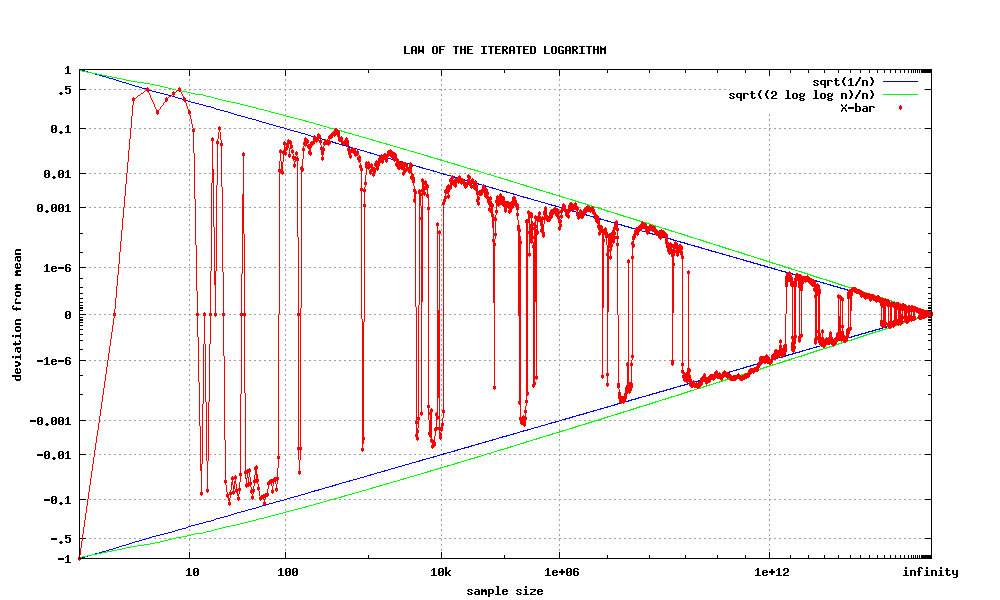
Law of the iterated logarithm
Encyclopedia

Probability theory
Probability theory is the branch of mathematics concerned with analysis of random phenomena. The central objects of probability theory are random variables, stochastic processes, and events: mathematical abstractions of non-deterministic events or measured quantities that may either be single...
, the law of the iterated logarithm describes the magnitude of the fluctuations of a random walk
Random walk
A random walk, sometimes denoted RW, is a mathematical formalisation of a trajectory that consists of taking successive random steps. For example, the path traced by a molecule as it travels in a liquid or a gas, the search path of a foraging animal, the price of a fluctuating stock and the...
. The original statement of the law of the iterated logarithm is due to A. Y. Khinchin (1924). Another statement was given by A.N. Kolmogorov
Andrey Kolmogorov
Andrey Nikolaevich Kolmogorov was a Soviet mathematician, preeminent in the 20th century, who advanced various scientific fields, among them probability theory, topology, intuitionistic logic, turbulence, classical mechanics and computational complexity.-Early life:Kolmogorov was born at Tambov...
in 1929.
Statement
Let {Yn} be independent, identically distributed random variables with means zero and unit variances. Let Sn = Y1 + … + Yn. Then-

where “log” is the natural logarithmNatural logarithmThe natural logarithm is the logarithm to the base e, where e is an irrational and transcendental constant approximately equal to 2.718281828...
, “lim sup” denotes the limit superior, and “a.s.” stands for “almost surelyAlmost surelyIn probability theory, one says that an event happens almost surely if it happens with probability one. The concept is analogous to the concept of "almost everywhere" in measure theory...
”.
Discussion
The law of iterated logarithms operates “in between” the law of large numbersLaw of large numbersIn probability theory, the law of large numbers is a theorem that describes the result of performing the same experiment a large number of times...
and the central limit theoremCentral limit theoremIn probability theory, the central limit theorem states conditions under which the mean of a sufficiently large number of independent random variables, each with finite mean and variance, will be approximately normally distributed. The central limit theorem has a number of variants. In its common...
. There are two versions of the law of large numbers — the weak and the strong — and they both claim that the sums Sn, scaled by n−1, converge to zero, respectively in probability and almost surely:-

On the other hand, the central limit theorem states that the sums Sn scaled by the factor n−½ converge in distribution to a standard normal distribution, which implies that these quantities do not converge to anything neither in probability nor almost surely:-

The law of the iterated logarithm provides the scaling factor where the two limits become different:-

Thus, although the quantity is less than any predefined ε > 0 with probability approaching one, that quantity will nevertheless be dropping out of that interval infinitely often, and in fact will be visiting the neighborhoods of any point in the interval (0,√2) almost surely.
is less than any predefined ε > 0 with probability approaching one, that quantity will nevertheless be dropping out of that interval infinitely often, and in fact will be visiting the neighborhoods of any point in the interval (0,√2) almost surely.
See also
- Central limit theoremCentral limit theoremIn probability theory, the central limit theorem states conditions under which the mean of a sufficiently large number of independent random variables, each with finite mean and variance, will be approximately normally distributed. The central limit theorem has a number of variants. In its common...
- Law of large numbersLaw of large numbersIn probability theory, the law of large numbers is a theorem that describes the result of performing the same experiment a large number of times...
- Brownian motionWiener processIn mathematics, the Wiener process is a continuous-time stochastic process named in honor of Norbert Wiener. It is often called standard Brownian motion, after Robert Brown...
- Central limit theorem
-
-
-

